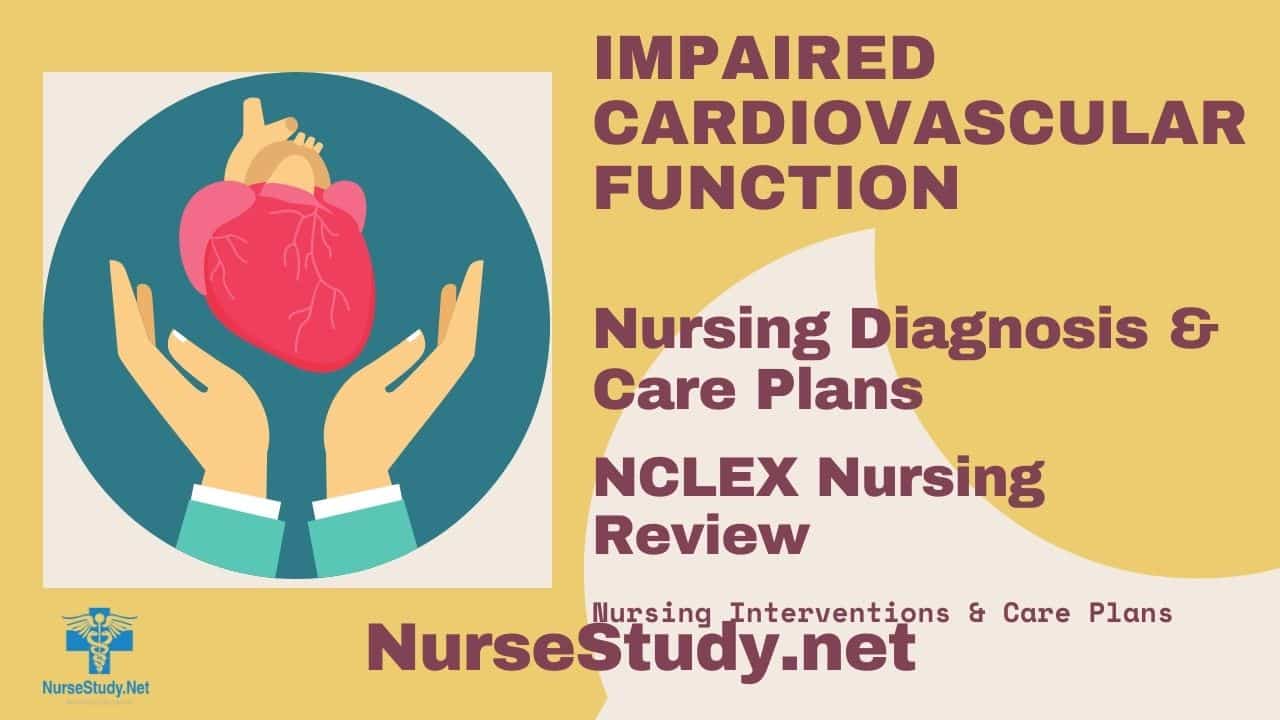Impaired cardiovascular function represents a condition where the heart and blood vessels fail to maintain adequate circulation to meet the body’s physiological needs. This nursing diagnosis focuses on identifying and managing cardiovascular dysfunction while preventing complications and promoting optimal cardiac health.
Causes (Related to)
Impaired cardiovascular function can stem from various factors affecting cardiac performance:
- Structural abnormalities:
- Congenital heart defects
- Valvular disease
- Cardiomyopathy
- Coronary artery disease
- Physiological factors:
- Hypertension
- Electrolyte imbalances
- Arrhythmias
- Blood volume changes
- Lifestyle factors:
- Obesity
- Sedentary behavior
- Poor dietary habits
- Smoking
- Medical conditions:
- Diabetes
- Thyroid disorders
- Chronic kidney disease
- Pulmonary diseases
Signs and Symptoms (As evidenced by)
Subjective: (Patient reports)
- Chest pain or discomfort
- Shortness of breath
- Fatigue and weakness
- Dizziness or lightheadedness
- Palpitations
- Exercise intolerance
- Anxiety about condition
Objective: (Nurse assesses)
- Abnormal vital signs
- Irregular heart rhythm
- Decreased cardiac output
- Edema
- Cyanosis
- Altered mental status
- Diminished peripheral pulses
- Abnormal heart sounds
Expected Outcomes
- The patient will maintain stable vital signs
- The patient will demonstrate improved cardiac function
- The patient will report reduced symptoms
- The patient will understand the medication regimen
- The patient will adopt heart-healthy lifestyle changes
- The patient will recognize warning signs requiring medical attention
- The patient will maintain optimal fluid balance
Nursing Assessment
Monitor Cardiovascular Status
- Assess vital signs
- Check heart rhythm
- Evaluate peripheral circulation
- Monitor cardiac output
- Assess for edema
Evaluate Symptoms
- Monitor pain levels
- Assess breathing pattern
- Check activity tolerance
- Evaluate mental status
- Document symptom changes
Review Risk Factors
- Family history
- Current medications
- Lifestyle habits
- Comorbid conditions
- Previous cardiac events
Check Compliance
- Medication adherence
- Dietary restrictions
- Exercise regime
- Follow-up appointments
- Lifestyle modifications
Assess Support System
- Family involvement
- Home care needs
- Community resources
- Educational needs
- Financial resources
Nursing Care Plans
Nursing Care Plan 1: Decreased Cardiac Output
Nursing Diagnosis Statement:
Decreased Cardiac Output related to altered contractility as evidenced by diminished peripheral pulses and fatigue.
Related Factors:
- Altered heart rate/rhythm
- Changes in contractility
- Altered preload/afterload
- Structural changes
Nursing Interventions and Rationales:
- Monitor vital signs hourly
Rationale: Detects early signs of decompensation - Assess peripheral circulation
Rationale: Indicates adequacy of cardiac output - Position patient for optimal cardiac function
Rationale: Reduces cardiac workload
Desired Outcomes:
- The patient will maintain stable vital signs
- The patient will demonstrate improved peripheral circulation
- The patient will report decreased fatigue
Nursing Care Plan 2: Activity Intolerance
Nursing Diagnosis Statement:
Activity Intolerance related to imbalance between oxygen supply and demand as evidenced by excessive fatigue with minimal exertion.
Related Factors:
- Decreased cardiac output
- Sedentary lifestyle
- Weakness
- Bed rest deconditioning
Nursing Interventions and Rationales:
- Implement a graduated activity program
Rationale: Builds endurance safely - Monitor response to activity
Rationale: Prevents overexertion - Teach energy conservation techniques
Rationale: Maximizes available energy
Desired Outcomes:
- The patient will demonstrate improved activity tolerance.
- The patient will participate in prescribed exercises
- The patient will use energy conservation techniques
Nursing Care Plan 3: Risk for Fluid Volume Excess
Nursing Diagnosis Statement:
Risk for Fluid Volume Excess related to compromised regulatory mechanisms as evidenced by edema and weight gain.
Related Factors:
- Decreased cardiac output
- Hormonal changes
- Sodium retention
- Medication side effects
Nursing Interventions and Rationales:
- Monitor daily weights
Rationale: Early indicator of fluid retention - Assess for edema
Rationale: Indicates fluid status - Maintain fluid restrictions
Rationale: Prevents fluid overload
Desired Outcomes:
- The patient will maintain a stable weight
- The patient will demonstrate reduced edema
- The patient will comply with fluid restrictions
Nursing Care Plan 4: Anxiety
Nursing Diagnosis Statement:
Anxiety related to threat to health status as evidenced by expressed concerns and increased vital signs.
Related Factors:
- Change in health status
- Threat to current lifestyle
- Fear of death
- Knowledge deficit
Nursing Interventions and Rationales:
- Provide clear information
Rationale: Reduces fear of the unknown - Teach coping strategies
Rationale: Helps manage anxiety - Include family in care planning
Rationale: Enhances support system
Desired Outcomes:
- The patient will verbalize decreased anxiety
- The patient will demonstrate coping strategies
- The patient will participate in care decisions
Nursing Care Plan 5: Ineffective Health Management
Nursing Diagnosis Statement:
Ineffective Health Management related to knowledge deficit as evidenced by failure to follow therapeutic regimen.
Related Factors:
- Complex treatment regimen
- Insufficient knowledge
- Lack of resources
- Cultural beliefs
Nursing Interventions and Rationales:
- Provide comprehensive education
Rationale: Improves understanding and compliance - Set realistic goals
Rationale: Promotes success and adherence - Connect with community resources
Rationale: Ensures continued support
Desired Outcomes:
- The patient will demonstrate an understanding of condition.
- The patient will adhere to the treatment plan
- The patient will utilize available resources
References
- Ernstmeyer K, Christman E, editors. Nursing Skills [Internet]. Eau Claire (WI): Chippewa Valley Technical College; 2021. Chapter 9 Cardiovascular Assessment. https://www.ncbi.nlm.nih.gov/books/NBK593199/
- Felner JM. An Overview of the Cardiovascular System. In: Walker HK, Hall WD, Hurst JW, editors. Clinical Methods: The History, Physical, and Laboratory Examinations. 3rd edition. Boston: Butterworths; 1990. Chapter 7. https://www.ncbi.nlm.nih.gov/books/NBK393/
- Paul, Sara DNP, RN, FNP; Hice, Amber RN, PCCN, CMC. Role of the Acute Care Nurse in Managing Patients With Heart Failure Using Evidence-Based Care. Critical Care Nursing Quarterly 37(4):p 357-376, October/December 2014. | DOI: 10.1097/CNQ.0000000000000036
- Zhou Y, Wang X, Lan S, Zhang L, Niu G, Zhang G. Application of evidence-based nursing in patients with acute myocardial infarction complicated with heart failure. Am J Transl Res. 2021 May 15;13(5):5641-5646. PMID: 34150170; PMCID: PMC8205824.
